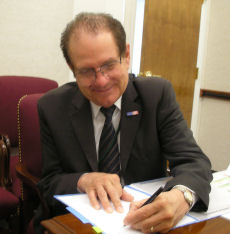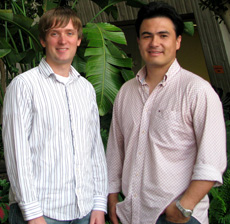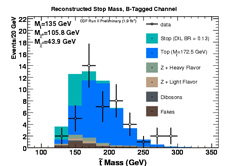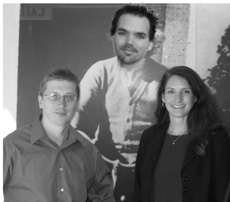|
Information on the furloughs at Fermilab, which stopped May 31, 2008, is available on the furlough Web pages.
|
|
Thursday, June 26
1 p.m.
Physics and Detector Seminar - West Wing, WH-10NW
Speaker: D. Mitchell, Fermilab
Title: ILC Cryomodules
3:30 p.m.
DIRECTOR'S COFFEE BREAK - 2nd Flr X-Over
THERE WILL BE NO ACCELERATOR PHYSICS AND TECHNOLOGY SEMINAR TODAY
Friday, June 27
11 a.m.
Theoretical Physics Seminar - WH-3NW(NOTE DATE, TIME, LOCATION)
Speaker: S. Pascoli, Durham University
Title: Detecting Dark Matter with Neutrino Detectors
3:30 p.m.
DIRECTOR'S COFFEE BREAK - 2nd Flr X-Over
4 p.m.
Joint Experimental-Theoretical Physics Seminar - One West
Speaker: P. Belli, University of Rome, Tor Vergata
Title: First Results from DAMA/LIBRA
Click here for NALCAL,
a weekly calendar with links to additional information.
|
|
Thursday, June 26
- Minnesota wild rice w/chicken
- Tuna melt on nine grain
- Italian meatloaf
- Chicken casserole
- Vegetarian salad wrap
- Assorted slice pizza
- Mandarin chicken
Wilson Hall Cafe menu |
|
Thursday, June 26
Dinner
- Closed
Wednesday, July 2
Lunch
- Poached salmon w/scallion sauce
- Lemon orzo w/pine nuts
- Summer vegetable medley
- Chocolate Kahlua flan
Chez Leon menu
Call x4598 to make your reservation. |
|
|
Let the physics begin

DOE Under Secretary for Science and Director of the Office of Science Raymond L. Orbach approves the formal completion of the U.S. LHC construction project.
U.S. LHC construction project declared formally complete
The decade-long project to help build CERN's LHC accelerator, and the ATLAS and CMS detectors culminated yesterday (June 25) when Dr. Raymond L. Orbach, Department of Energy under secretary for science and director of the Office of Science, announced the formal completion of the U.S. LHC construction project.
More than 1,200 physicists, engineers and technicians from 90 U.S. universities and national laboratories contributed to this significant milestone, officially known as Critical Decision-4B.
"I would like to congratulate the physicists, engineers and technicians who made the U.S. LHC construction project possible," Orbach said. "The U.S. has made important contributions to this impressive international effort."
The DOE and National Science Foundation jointly funded the $531 million project. Close coordination between the funding agencies, U.S. universities and national laboratories resulted in the on-time and on-budget delivery of all U.S. components.
"We are proud to have partnered with the DOE in supporting the U.S. LHC collaborations in this historic international effort," said Joseph Dehmer, physics division director of the National Science Foundation. "We also note with pride the excellent performance of the construction project, and we look forward to the period of scientific discovery that will result."
Read more
-- Elizabeth Clements
|
GSA poster award winners

At the annual Users' meeting June 4-5, a panel of judges selected three winners from the 60 posters presented. Winners received monetary awards from URA. From left: Jason Slaunwhite, CDF collaborator from Ohio State University, was selected for his poster titled "The Search for Higgs Bosons Produced in Association with W Bosons at CDF." Jorge Benitez, a DZero collaborator from Michigan State University, was selected for his poster titled "Single Top Quark Production at D0 Using Boosted Decision Trees." Not pictured: Marcelle Soares-Santos, a collaborator in Fermilab's Dark Energy Survey groups from San Paulo University in Brazil. Soares-Santos' poster was titled "Voronoi Tesselation Cluster Finding Algorithm."
|
Doomsday lawsuit dissed
From MSNBC Cosmic Log,
June 24, 2008
The federal government today struck back in force against a lawsuit that has raised an alarm over the world's biggest particle collider. In 40 documents comprising hundreds of pages, attorneys and government officials contended that "scientifically, there is no basis for any conceivable threat" from black holes or the other theoretical horrors posed in the suit.
If the government has its way, the lawsuit would be thrown out on procedural grounds even before getting to the scientific arguments.
The civil suit, filed in Hawaii's U.S. District Court in March, contends that Europe's Large Hadron Collider might destroy the earth by creating microscopic black holes or other exotic phenomena. The plaintiffs in the case - Spanish science writer Luis Sancho and Walter Wagner, a retired nuclear physicist who lives in Hawaii - want the court to put a hold on collider operations to leave more time for safety reviews.
Sancho and Wagner's call for a go-slow approach runs counter to the prevailing scientific view that the LHC poses no globe-gobbling risk. Just last Friday, Europe's CERN nuclear research organization issued a safety report reiterating that view - and in today's filings, the U.S. Department of Energy said it accepted the findings of that report, as well as earlier reports that came to similar conclusions.
Critics have tried to poke holes in those safety reports, but one of the documents filed today says the Energy Department "is not aware of a single instance where the conclusions of those reports have been contested or rebutted in any particle physics peer-reviewed or scholarly forum."
Read more
|
|
|
Are stop and top
fraternal twins?

The figure shows the reconstructed mass distribution of the hypothetical stop quark. Stop events are not favored by the data.
According to one of the most popular extensions of the Standard Model, supersymmetry, every particle has its own super partner. In many supersymmetric models, the super partners are heavier than their Standard Model partners. In some models, the stop quark, the partner of the top quark, might be lighter than the top quark. CDF scientists are looking at one of those models that also attempts to explain the matter-antimatter asymmetry in the universe.
These light stop quarks could have the same experimental signature as top quarks and could explain a historic inconsistency in the top mass measurements. The inconsistency is found between decay channels involving one and two leptons in the final state. If such a light stop quark were to exist, a larger fraction of stop than top quark decays would produce two leptons, and thus create an apparent difference in the measured top masses.
The authors of a new CDF analysis have developed an algorithm to fully reconstruct the mass of these hypothetical stop events in the channel involving two leptons. In this channel, in contrast to top decays that contain two neutrinos, this stop decay has four particles, two neutrinos and two neutralinos, which leave no traces in the detector.
Fully reconstructing all four of these invisible particles is not possible because of too many unknown parameters and limited constraints from data. The CDF scientists came up with a clever trick that consists of pairing up these particles into two "pseudo-particles," thus rendering the problem solvable.
Even after this creative reconstruction, it still remains difficult to distinguish the tiny stop signal from the Standard Model events. To help, the CDF team devised a method to optimize the event selection for maximum sensitivity including all systematic uncertainties. To do this, scientists had to recompute the systematics and sensitivity of the analysis tens of thousands of times.
When the authors looked at the reconstructed mass of the data events and compared the results to the expected Standard Model processes, they found no evidence for such light stop quarks. These scientists have set the world's first limits in this stop decay channel with two leptons.
Read more

Andrew Ivanov, Will Johnson's head (on Einstein's body) and Robin Erbacher, all from UC Davis.
Result of the Week Archive
|
Telecom correction
To those employees who receive the Telecom Asset Inventory currently being distributed by the Mailroom: The block of instructional text at the end of the report you receive may contain errors. Some reports incorrectly state that your completed inventory should be returned to Mail Station 337. This should have read Mail Station 228. Additionally, inquiries pertaining to your asset inventory should be directed to telecom@fnal.gov or x5411.
Please make a note of these changes and return your completed inventory to Mail Station 228 by the July 18 deadline.
The Telecommunications Office regrets this error and apologizes for any inconvenience it has caused.
|
|
Have a safe day!
International Folk Dance Thursday
International Folk Dancing will take place in the Wilson Hall Auditorium this Thursday, June 26. Dancing begins at 7:30 p.m. with teaching and children's dances earlier in the evening and request dancing later on. For more information, call (630) 584-0825 or (630) 840-8194 or e-mail.
Visa Office Closed
The Visa Office will be closed the week of June 23-27. Urgent matters only may be addressed during that week to Borys Jurkiw at visaoffice@fnal.gov or x4363.
Additional Activities |
|